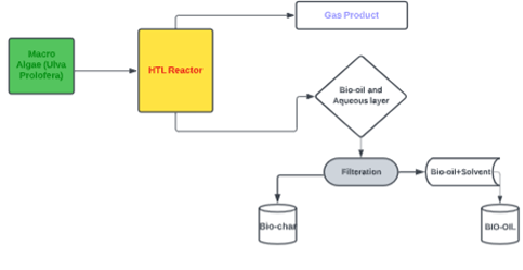
The utilization of macroalgae, specifically Ulva prolifera, for the manufacture of bio-crude demonstrates great potential as a viable alternative to conventional fossil fuels. This is mostly owing to its abundant availability and renewable characteristics, making it an optimal choice for bio-oil production. This study examined the synthesis of bio-crude through the Hydrothermal Liquefaction (HTL) method. The combination of Ultra-sonicated Ulva prolifera, Chicken Waste, and water facilitated the transformation of the moist biomass into Bio-crude. The study also examined the influence of process parameters, including the optimal operational temperature, retention time, and feedstock mixing ratio (275 oC, 30 minutes, and 1:4 ratio) for the graphene-C3N4 catalyst, KOH. The study's findings verified that a significant amount of bio-oil, specifically 23.5wt.% based on dry weight measurements, was successfully produced. Bio-oil mostly consists of alcohols, esters, phenols, ketones, and acidic chemicals. Furthermore, the bio-oil exhibited a significant heating value of 38.15 MJ/kg, which can be attributed to the presence of carboxylic acid groups and aliphatic hydrocarbons. Furthermore, the carbon content in the bio-oil was found to be double that of the macroalgae used as feedstock. Additionally, the heating value of the bio-oil was shown to be 2.5 times greater than that of the macroalgae. Hydrothermal liquefaction may be used to efficiently create bio-oil from Ulva prolifera, a third-generation fuel that has great potential as an environmentally benign and sustainable energy source.
Total file downloads: 15